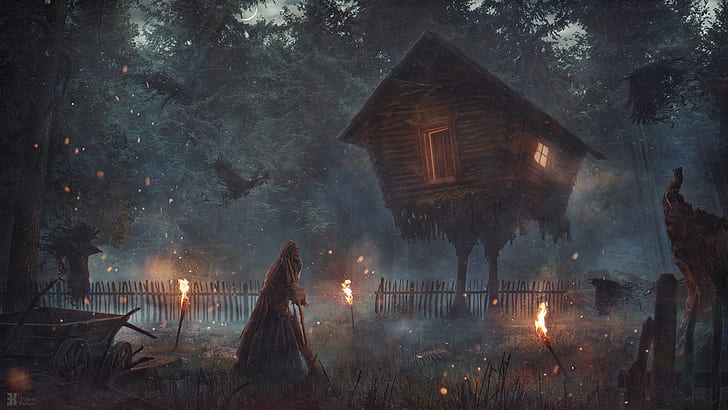Table of Contents
ToggleBaba Yaga House, Baba Yaga is one of the most iconic and enigmatic figures in Slavic folklore. She is often depicted as an old, fearsome witch who possesses great knowledge and power. However, what makes Baba Yaga even more intriguing is her magical, mobile house, which stands on giant chicken legs. This legendary dwelling is not only a crucial part of her myth but also a symbol of her otherworldly nature.
In this article, we will explore the origins of Baba Yaga house, its role in folklore, its symbolic meanings, and how it has influenced modern media. Whether you are a folklore enthusiast, a literature lover, or just someone fascinated by the supernatural, this deep dive into Baba Yaga house will surely capture your imagination.
The Origins of Baba Yaga House in Slavic Folklore
The First Mentions of Baba Yaga House
The earliest recorded references to Baba Yaga house can be traced back to ancient Slavic oral traditions. These tales, passed down through generations, describe her dwelling as a hut that stands on giant chicken legs and can move or spin around at will. Unlike ordinary homes, Baba Yaga house is not bound to one place and appears to have a mind of its own.
This unique concept sets Baba Yaga apart from other witches and supernatural beings in folklore. While many cultures have myths about wicked sorceresses living in forests, none have a house as strange and sentient as hers.
Its Connection to Nature and the Supernatural
Baba Yaga house is usually found deep in an enchanted forest, often surrounded by a fence made of human bones and skulls. This eerie setting emphasizes her connection to the supernatural world and her role as a guardian of the unknown. The house is both a place of refuge and danger—those who enter must prove their worth or face dire consequences.
In many stories, travelers seeking wisdom, magical items, or assistance are drawn to Baba Yaga house. However, gaining her favor is never easy, as she is known for testing the courage and cleverness of those who approach her.
The House’s Ability to Move and Hide
One of the most fascinating aspects of Baba Yaga house is its ability to move. Unlike traditional homes, it does not remain in one location and can rotate or flee from uninvited guests. The house responds to a special chant: “Turn your back to the forest, your front to me!” This command can make the house change its orientation, revealing its entrance or hiding it from view.
This mobility suggests that Baba Yaga’s home exists on the boundary between the known and unknown worlds. It is neither fully part of human civilization nor completely separate from it, reinforcing the idea that Baba Yaga herself is a liminal figure who straddles multiple realms.
Symbolic Meanings of Baba Yaga House
A Portal Between Worlds
Baba Yaga house is often interpreted as a threshold between different realms. It exists in the mortal world but has strong ties to the supernatural. Many scholars believe that the house represents a portal to the spirit world, where hidden knowledge, magic, and transformation take place.
Travelers who reach Baba Yaga house often undergo trials that lead to personal growth or revelation. In this sense, the house is not merely a dwelling but a gateway to wisdom and self-discovery.
The Chicken Legs: A Unique Architectural Feature
The house’s chicken legs are one of its most unusual features. Some believe that this imagery originates from ancient Slavic burial customs, where houses on stilts were used to protect the dead from scavengers. Over time, this burial practice may have inspired the depiction of Baba Yaga house as a living structure capable of movement.
Others interpret the chicken legs as a symbol of unpredictability and chaos. Just like Baba Yaga herself, her house defies logic and expectations, making it a powerful representation of magic and the unknown.
The Fence of Skulls: A Warning to Outsiders
In many versions of Baba Yaga’s legend, her house is surrounded by a fence made of human bones, with skulls mounted on top. This gruesome decoration serves as a warning to trespassers that they may meet the same fate if they do not respect Baba Yaga’s rules.
However, the fence also symbolizes her role as a guardian of knowledge. Those who dare to seek wisdom from Baba Yaga must prove themselves worthy, often by demonstrating intelligence, bravery, or resourcefulness.
Baba Yaga House in Modern Culture
Influence on Literature and Fairy Tales
Baba Yaga house has appeared in countless fairy tales, books, and folklore adaptations. Stories like “Vasilisa the Beautiful” feature the hut prominently, using it as a setting for trials and magical encounters. Writers such as Alexander Afanasyev and Ivan Bilibin helped popularize these tales in the 19th and early 20th centuries.
Even today, authors continue to draw inspiration from Baba Yaga house, using it as a symbol of mystery, danger, and transformation.
Representation in Film and Television
Baba Yaga house has made its way into various films, animated series, and television shows. From its eerie appearance in animated adaptations of Russian folklore to its inclusion in fantasy films like Hellboy (2019), the house remains an enduring symbol of Slavic mythology.
In some modern interpretations, Baba Yaga is depicted as a powerful ally rather than a villain, and her house serves as a place of refuge and magical guidance.
The House in Video Games and Popular Media
Gamers may recognize Baba Yaga house from titles like The Witcher 3, Rise of the Tomb Raider, and other fantasy-themed games. These games use the myth of Baba Yaga and her moving hut to create eerie, immersive environments that blend horror and fantasy elements.
Beyond gaming, Baba Yaga house has also been referenced in comics, music, and even fashion. Its unique visual appeal and deep mythological roots make it a favorite among artists and storytellers.
Conclusion: The Enduring Legacy of Baba Yaga House
Baba Yaga house is more than just a strange and supernatural dwelling—it is a powerful symbol of mystery, magic, and transformation. Whether seen as a portal between worlds, a test of character, or simply a fantastical element of Slavic folklore, the house continues to fascinate and inspire audiences around the world.
From ancient legends to modern adaptations, Baba Yaga’s house remains one of the most intriguing and enduring symbols in folklore. It serves as a reminder that the unknown is not something to be feared, but something to be explored and understood.















Your blog brightens my day like a ray of sunshine. Thank you for spreading positivity through your words.
Your blog keeps me engaged from start to finish. I can never move on without devouring your entire post.
The article is thought-provoking and challenging. Thanks for sharing your original perspective on this topic.
This article hit the nail on the head; that’s exactly what I needed to hear.
I don’t think the title of your article matches the content lol. Just kidding, mainly because I had some doubts after reading the article.
Эта платформа публикует интересные новости разных сфер.
Здесь можно найти аналитика, науке и других областях.
Информация обновляется в режиме реального времени, что позволяет не пропустить важное.
Простой интерфейс облегчает восприятие.
https://beautydom-salon.ru
Все публикации написаны грамотно.
Редакция придерживается честной подачи.
Читайте нас регулярно, чтобы быть на волне новостей.
Эта платформа публикует свежие новостные материалы разных сфер.
Здесь доступны аналитика, технологиях и многом другом.
Информация обновляется ежедневно, что позволяет не пропустить важное.
Понятная навигация помогает быстро ориентироваться.
https://moismi.ru
Каждая статья предлагаются с фактчеком.
Редакция придерживается информативности.
Следите за обновлениями, чтобы быть всегда информированными.
На данном сайте вы найдете мессенджер-бот “Глаз Бога”, что проверить данные по человеку по публичным данным.
Сервис работает по фото, используя публичные материалы онлайн. С его помощью осуществляется 5 бесплатных проверок и полный отчет по имени.
Платфор ма актуален на 2025 год и поддерживает фото и видео. Сервис сможет найти профили по госреестрам и предоставит результаты в режиме реального времени.
глаз бога бот бесплатно
Это сервис — помощник при поиске граждан через Telegram.
Здесь можно получить Telegram-бот “Глаз Бога”, позволяющий собрать данные по человеку из открытых источников.
Сервис активно ищет по номеру телефона, используя доступные данные онлайн. Благодаря ему можно получить бесплатный поиск и детальный анализ по запросу.
Инструмент обновлен на 2025 год и включает мультимедийные данные. Глаз Бога поможет проверить личность в открытых базах и отобразит результаты мгновенно.
глаз бога бесплатно на телефон
Данный инструмент — выбор для проверки персон удаленно.
Нужно собрать данные о человеке ? Наш сервис поможет детальный отчет мгновенно.
Воспользуйтесь продвинутые инструменты для анализа цифровых следов в соцсетях .
Узнайте место работы или интересы через автоматизированный скан с верификацией результатов.
найти через глаз бога
Система функционирует с соблюдением GDPR, обрабатывая общедоступную информацию.
Закажите детализированную выжимку с геолокационными метками и списком связей.
Доверьтесь проверенному решению для исследований — результаты вас удивят !
Хотите собрать информацию о человеке ? Наш сервис предоставит полный профиль в режиме реального времени .
Воспользуйтесь уникальные алгоритмы для поиска публичных записей в соцсетях .
Узнайте контактные данные или интересы через автоматизированный скан с верификацией результатов.
глаз бога телеграмм официальный бот
Бот работает с соблюдением GDPR, используя только открытые данные .
Закажите расширенный отчет с геолокационными метками и списком связей.
Попробуйте надежному помощнику для исследований — результаты вас удивят !
Matchmaking services provide a modern way to meet people globally, combining user-friendly features like profile galleries and compatibility criteria.
Key elements include secure messaging , social media integration, and personalized profiles to enhance interactions .
Advanced algorithms analyze behavioral patterns to suggest potential partners , while privacy settings ensure trustworthiness.
https://sdzgw.org/dating/gay-porn-in-mainstream-adult-platforms/
Leading apps offer premium subscriptions with enhanced visibility, such as unlimited swipes , alongside profile performance analytics.
Whether seeking casual chats , these sites adapt to user goals, leveraging AI-driven recommendations to foster meaningful bonds.
Хотите собрать данные о пользователе? Этот бот предоставит полный профиль мгновенно.
Используйте продвинутые инструменты для анализа публичных записей в открытых источниках.
Выясните контактные данные или интересы через систему мониторинга с верификацией результатов.
глаз бога телеграм бесплатно
Система функционирует в рамках закона , используя только общедоступную информацию.
Получите расширенный отчет с историей аккаунтов и графиками активности .
Доверьтесь надежному помощнику для исследований — результаты вас удивят !
Нужно найти информацию о пользователе? Наш сервис поможет полный профиль мгновенно.
Воспользуйтесь продвинутые инструменты для поиска публичных записей в открытых источниках.
Узнайте место работы или интересы через систему мониторинга с верификацией результатов.
глаз бога программа для поиска
Система функционирует в рамках закона , обрабатывая общедоступную информацию.
Закажите детализированную выжимку с историей аккаунтов и списком связей.
Доверьтесь проверенному решению для digital-расследований — результаты вас удивят !